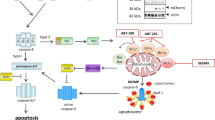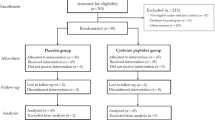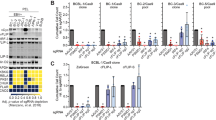Abstract
Past studies have identified a number of distinct mechanisms that contribute to the resistance of melanoma cells against apoptosis induced by TNF-related apoptosis-inducing ligand (TRAIL). In this report we show that cystatin B is another endogenous inhibitor of TRAIL-induced apoptosis. Cystatin B-deficient melanoma cell lines established by shRNA knockdown displayed increased apoptosis that was associated with enhanced activation of caspase-8 induced by TRAIL. This was not related to the inhibitory effect of cystatin B on the lysosomal cysteine proteases, cathepsin B and L, as they did not have a role in TRAIL-induced apoptosis in most melanoma cell lines even when cystatin B was inhibited. Instead, sensitization of melanoma cells to TRAIL-induced apoptosis by inhibition of cystatin B appeared associated with decreased stability of FLIPL as the levels of FLIPL were reduced because of shortened half-life time in melanoma cells deficient in cystatin B. In contrast, over-expression of cystatin B increased the levels of FLIPL, decreased the amount of the E3 ligase Itch associated with FLIPL, and reduced FLIPL ubiquitination. Inhibition of Itch by siRNA restored the levels of FLIPL and blocked sensitization to TRAIL-induced apoptosis associated with deficiency in cystatin B. Taken together, these results indicate that cystatin B regulates Itch-mediated degradation of FLIPL and thereby TRAIL-induced apoptosis in melanoma cells.
Similar content being viewed by others
Log in or create a free account to read this content
Gain free access to this article, as well as selected content from this journal and more on nature.com
or
Abbreviations
- CA074Me:
-
L-3-trans-(propylcarbamoyl)oxirane-2-carbonyl]-L-isoleucyl-L-proline methyl ester
- DISC:
-
death-inducing signaling complex
- FADD:
-
Fas-associated death domain
- FLIP:
-
FLICE-like inhibitory protein
- MAb:
-
monoclonal antibody
- MG132:
-
carbobenzoxy-L-leucyl-L-leucyl-L-leucinal
- ΔΨm:
-
mitochondrial membrane potential
- PI:
-
propidium iodide
- shRNA:
-
Short hairpin RNA
- siRNA:
-
Small interference RNA
- TRAIL:
-
TNF-related apoptosis-inducing ligand
- TRAIL-R:
-
TRAIL receptor
- z-IETD-fmk:
-
z-lle-Glu(Ome)-Thr-Asp(Ome)-CH2F
References
Nagata S . Apoptosis by death factor. Cell 1997; 88: 355–365.
Ashkenazi A, Dixit VM . Death receptors: signaling and modulation. Science 1998; 281: 1305–1308.
Walczak H, Krammer PH . The CD95 (APO-1/Fas) and the TRAIL (APO-2L) apoptosis systems. Exp Cell Res 2000; 256: 58–66.
Hersey P, Zhang XD . How melanoma cells evade trail-induced apoptosis. Nat Rev Cancer 2001; 1: 142–150.
Irmler M, Thome M, Hahne M, Schneider P, Hofmann K, Steiner V et al. Inhibition of death receptor signals by cellular FLIP. Nature 1997; 388: 190–195.
Yu JW, Shi Y . FLIP and the death effector domain family. Oncogene 2008; 27: 6216–6227.
Leist M, Jäättelä M . Triggering of apoptosis by cathepsins. Cell Death Differ 2001; 8: 324–326.
Foghsgaard L, Wissing D, Mauch D, Lademann U, Bastholm L, Boes M et al. Cathepsin B acts as a dominant execution protease in tumor cell apoptosis induced by tumor necrosis factor. J Cell Biol 2001; 153: 999–1010.
Yuan XM, Li W, Dalen H, Lotem J, Kama R, Sachs L et al. Lysosomal destabilization in p53-induced apoptosis. Proc Natl Acad Sci USA 2002; 99: 6286–6291.
Guicciardi ME, Leist M, Gores GJ . Lysosomes in cell death. Oncogene 2004; 23: 2881–2890.
Nagaraj NS, Vigneswaran N, Zacharias W . Cathepsin B mediates TRAIL-induced apoptosis in oral cancer cells. J Cancer Res Clin Oncol 2006; 132: 171–183.
Werneburg NW, Guicciardi ME, Bronk SF, Kaufmann SH, Gores GJ . Tumor necrosis factor-related apoptosis-inducing ligand activates a lysosomal pathway of apoptosis that is regulated by Bcl-2 proteins. J Biol Chem 2007; 282: 28960–28970.
Giammarioli AM, Maselli A, Casagrande A, Gambardella L, Gallina A, Spada M et al. Pyrimethamine induces apoptosis of melanoma cells via a caspase and cathepsin double-edged mechanism. Cancer Res 2008; 68: 5291–5300.
Keppler D . Towards novel anti-cancer strategies based on cystatin function. Cancer Lett 2006; 235: 159–176.
Joensuu T, Lehesjoki AE, Kopra O . Molecular background of EPM1-Unverricht-Lundborg disease. Epilepsia 2008; 49: 557–563.
Lee MJ, Yu GR, Park SH, Cho BH, Ahn JS, Park HJ et al. Identification of cystatin B as a potential serum marker in hepatocellular carcinoma. Clin Cancer Res 2008; 14: 1080–1089.
Feldman AS, Banyard J, Wu CL, McDougal WS, Zetter BR . Cystatin B as a tissue and urinary biomarker of bladder cancer recurrence and disease progression. Clin Cancer Res 2009; 15: 1024–1031.
Jiang CC, Mao ZG, Avery-Kiejda KA, Wade M, Hersey P, Zhang XD . Glucose-regulated protein 78 antagonizes cisplatin and adriamycin in human melanoma cells. Carcinogenesis 2009; 30: 197–204.
Jiang CC, Wroblewski D, Yang F, Hersey P, Zhang XD . Human melanoma cells under endoplasmic reticulum stress are more susceptible to apoptosis induced by the BH3 mimetic obatoclax. Neoplasia 2009; 11: 945–955.
Keppler D, Sloane BF . Cathepsin B: multiple enzyme forms from a single gene and their relation to cancer. Enzyme Protein 1996; 49: 94–105.
Zhang XD, Zhang XY, Gray CP, Nguyen T, Hersey P . Tumor necrosis factor-related apoptosis-inducing ligand-induced apoptosis of human melanoma is regulated by smac/DIABLO release from mitochondria. Cancer Res 2001; 61: 7339–7348.
Chang L, Kamata H, Solinas G, Luo JL, Maeda S, Venuprasad K et al. The E3 ubiquitin ligase itch couples JNK activation to TNFalpha-induced cell death by inducing c-FLIP(L) turnover. Cell 2006; 124: 601–613.
Di Piazza M, Mader C, Geletneky K, Herrero Y, Calle M, Weber E et al. Cytosolic activation of cathepsins mediates parvovirus H-1-induced killing of cisplatin and TRAIL-resistant glioma cells. J Virol 2007; 81: 4186–4198.
Chawla-Sarkar M, Bae SI, Reu FJ, Jacobs BS, Lindner DJ, Borden EC . Downregulation of Bcl-2, FLIP or IAPs (XIAP and survivin) by siRNAs sensitizes resistant melanoma cells to Apo2L/TRAIL-induced apoptosis. Cell Death Differ 2004; 11: 915–923.
Micheau O, Lens S, Gaide O, Alevizopoulos K, Tschopp J . NF-kappaB signals induce the expression of c-FLIP. Mol Cell Biol 2001; 21: 5299–5305.
Fukazawa T, Fujiwara T, Uno F, Teraishi F, Kadowaki Y, Itoshima T et al. Accelerated degradation of cellular FLIP protein through the ubiquitin-proteasome pathway in p53-mediated apoptosis of human cancer cells. Oncogene 2001; 20: 5225–5231.
Palacios C, Yerbes R, López-Rivas A . Flavopiridol induces cellular FLICE-inhibitory protein degradation by the proteasome and promotes TRAIL-induced early signaling and apoptosis in breast tumor cells. Cancer Res 2006; 66: 8858–8869.
Pickart CM . Mechanisms underlying ubiquitination. Annu Rev Biochem 2001; 70: 503–533.
Kaunisto A, Kochin V, Asaoka T, Mikhailov A, Poukkula M, Meinander A et al. PKC-mediated phosphorylation regulates c-FLIP ubiquitylation and stability. Cell Death Differ 2009; 16: 1215–1226.
Shi B, Tran T, Sobkoviak R, Pope RM . Activation-induced degradation of FLIP(L) is mediated via the phosphatidylinositol 3-kinase/Akt signaling pathway in macrophages. J Biol Chem 2009; 284: 14513–14523.
Llobet D, Eritja N, Encinas M, Llecha N, Yeramian A, Pallares J et al. CK2 controls TRAIL and Fas sensitivity by regulating FLIP levels in endometrial carcinoma cells. Oncogene 2008; 27: 2513–2524.
Abedini MR, Muller EJ, Brun J, Bergeron R, Gray DA, Tsang BK . Cisplatin induces p53-dependent FLICE-like inhibitory protein ubiquitination in ovarian cancer cells. Cancer Res 2008; 68: 4511–4517.
Turk V, Stoka V, Turk D . Cystatins: biochemical and structural properties, and medical relevance. Front Biosci 2008; 13: 5406–5420.
Lieuallen K, Pennacchio LA, Park M, Myers RM, Lennon GG . Cystatin B-deficient mice have increased expression of apoptosis and glial activation genes. Hum Mol Genet 2001; 10: 1867–1871.
Kopitar-Jerala N, Schweiger A, Myers RM, Turk V, Turk B . Sensitization of stefin B-deficient thymocytes towards staurosporin-induced apoptosis is independent of cysteine cathepsins. FEBS Lett 2005; 579: 2149–2155.
Lehtinen MK, Tegelberg S, Schipper H, Su H, Zukor H, Manninen O et al. Cystatin B deficiency sensitizes neurons to oxidative stress in progressive myoclonus epilepsy, EPM1. J Neurosci 2009; 29: 5910–5915.
Lee MW, Park SC, Kim JH, Kim IK, Han KS, Kim KY et al. The involvement of oxidative stress in tumor necrosis factor (TNF)-related apoptosis-inducing ligand (TRAIL)-induced apoptosis in HeLa cells. Cancer Lett 2002; 182: 75–82.
Chen LH, Jiang CC, Watts R, Thorne RF, Kiejda KA, Zhang XD et al. Inhibition of endoplasmic reticulum stress-induced apoptosis of melanoma cells by the ARC protein. Cancer Res 2008; 68: 834–842.
Nakajima A, Kojima Y, Nakayama M, Yagita H, Okumura K, Nakano H . Downregulation of c-FLIP promotes caspase-dependent JNK activation and reactive oxygen species accumulation in tumor cells. Oncogene 2008; 27: 76–84.
Jiang CC, Lucas K, Avery-Kiejda KA, Wade M, deBock CE, Thorne RF et al. Up-regulation of Mcl-1 is critical for survival of human melanoma cells upon endoplasmic reticulum stress. Cancer Res 2008; 68: 6708–6717.
Acknowledgements
This work was supported by the NSW State Cancer Council, the Melanoma and Skin Cancer Research Institute Sydney, the Hunter Melanoma Foundation, NSW, and the National Health and Medical Research Council (NHMRC), Australia. XD Zhang is a Cancer Institute NSW Fellow. The authors thank Dr. D-G Kim (Korea Research Institute of Bioscience and Biotechnology, Daejeon, Republic of Korea) for the pcDNA3.1 vector carrying cystatin B cDNA, and Dr H Nakano (Juntendo University School of Medicine, Tokyo, Japan) for the pCR vector carrying FLIPL cDNA and FLIPS cDNA.
Author information
Authors and Affiliations
Corresponding authors
Ethics declarations
Competing interests
The authors declare no conflict of interest.
Additional information
Edited by RA Knight
Supplementary Information accompanies the paper on Cell Death and Differentiation website
Supplementary information
Rights and permissions
About this article
Cite this article
Yang, F., Tay, K., Dong, L. et al. Cystatin B inhibition of TRAIL-induced apoptosis is associated with the protection of FLIPL from degradation by the E3 ligase itch in human melanoma cells. Cell Death Differ 17, 1354–1367 (2010). https://doi.org/10.1038/cdd.2010.29
Received:
Revised:
Accepted:
Published:
Issue date:
DOI: https://doi.org/10.1038/cdd.2010.29
Keywords
This article is cited by
-
The E3 ubiquitin ligase Itch regulates death receptor and cholesterol trafficking to affect TRAIL-mediated apoptosis
Cell Death & Disease (2024)
-
RP-HPLC-ESI-IT Mass Spectrometry Reveals Significant Variations of the Human Salivary Protein Profile Associated with Predominantly Antibody Deficiencies
Journal of Clinical Immunology (2020)
-
ITCH-dependent proteasomal degradation of c-FLIP induced by the anti-HER3 antibody 9F7-F11 promotes DR5/caspase 8-mediated apoptosis of tumor cells
Cell Communication and Signaling (2019)
-
RUNX3 enhances TRAIL-induced apoptosis by upregulating DR5 in colorectal cancer
Oncogene (2019)
-
RIP1 protects melanoma cells from apoptosis induced by BRAF/MEK inhibitors
Cell Death & Disease (2018)



